E-bike classifications help you understand the rules for riding an electric bicycle. These categories show how each e-bike works and where you can ride it. Class 1 e-bikes use pedal-assist and stop helping at 20 mph. Class 2 models add a throttle but also stop at 20 mph. Class 3 e-bikes use pedal-assist only and reach up to 28 mph. Knowing e-bike classifications keeps you safe and legal when you choose an ebike or electric bike for your needs.
Key Takeaways
-
E-bikes fall into three classes based on motor type and speed: Class 1 and 3 use pedal-assist only, while Class 2 adds a throttle option.
-
Class 1 and 2 e-bikes assist up to 20 mph, but Class 3 e-bikes can reach 28 mph and often require helmets and speedometers.
-
Knowing your e-bike class helps you follow local laws, ride safely, and access the right trails, roads, or bike lanes.
-
Always check state and local rules for age limits, helmet requirements, and where you can ride your e-bike to stay legal.
-
Choose an e-bike class that fits your riding style and needs, whether for fun, commuting, or speed, and maintain safety gear and bike condition.
E-Bike Classifications Overview

Three-Class System
You need to understand the three-class e-bike system before you choose an electric bicycle. This system helps you know how each type of e-bike works and where you can ride it. Most states in the U.S. use this system to set clear rules for riders and manufacturers. As of 2025, 37 states have adopted the three-class e-bike classification system. These states include New York, Texas, Utah, Michigan, and many others. The three-class e-bike system makes it easier for you to follow the law and stay safe.
Here is a table that shows the main features of each electric bike category:
|
E-Bike Class |
Motor Assistance Type |
Maximum Assisted Speed |
Additional Features |
|---|---|---|---|
|
Class 1 |
Pedal Assist System (PAS) only |
20 mph |
Motor cuts out at 20 mph |
|
Class 2 |
PAS + Throttle |
20 mph |
Motor cuts out at 20 mph |
|
Class 3 |
PAS only |
28 mph |
Motor cuts out at 28 mph; must have speedometer; no throttle |
You can also see the differences in motor operation and speed limits in the chart below:
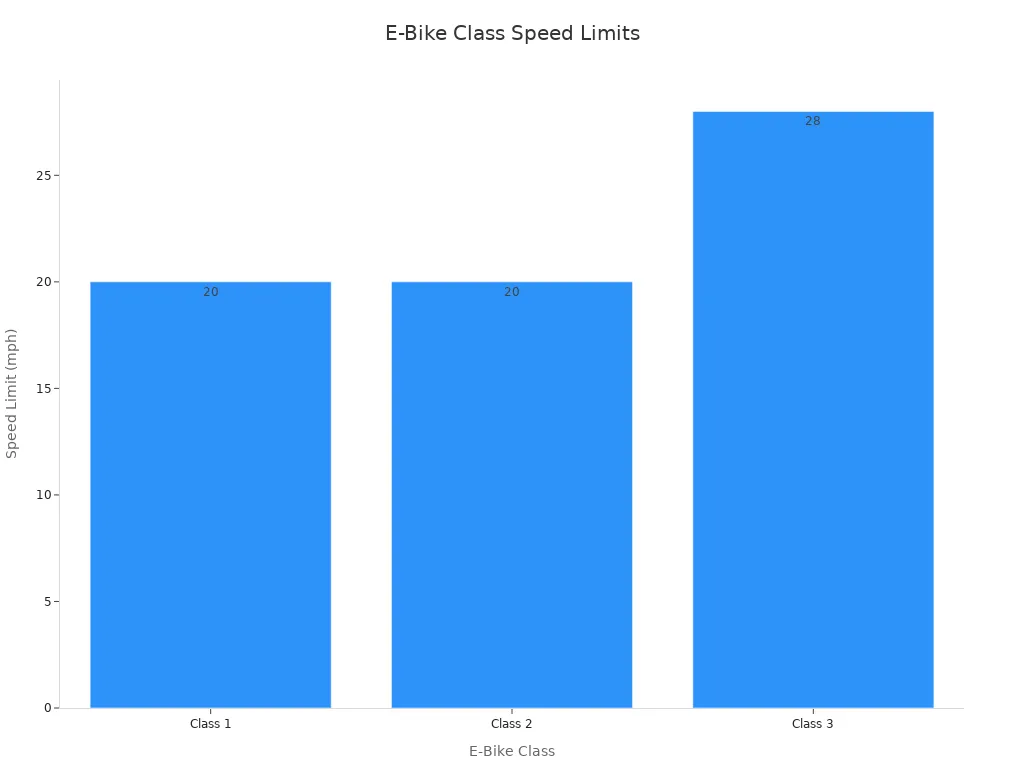
-
Class 1 e-bikes use pedal-assist only. The motor helps you when you pedal and stops at 20 mph.
-
Class 2 e-bikes let you use a throttle or pedal-assist. The motor also stops at 20 mph.
-
Class 3 e-bikes use pedal-assist only and can help you reach up to 28 mph. These bikes must have a speedometer and cannot use a throttle.
The three-class e-bike system gives you a clear way to compare different ebikes. You can pick the right electric bike for your needs and know what to expect from each class.
Why Classifications Matter
E-bike classifications matter because they affect where and how you can ride your ebike. The three-class e-bike system helps you, other riders, and law enforcement understand the rules. When you know your e-bike classification, you can avoid breaking the law and stay safe.
Tip: Always check your local rules before riding your electric bicycle. Some trails or bike paths may only allow certain classes of e-bikes.
Policymakers created the three-class e-bike system for several reasons:
-
They want to keep you safe by setting speed limits and clear rules for each electric bike category.
-
The system helps reduce injuries and accidents by matching helmet laws and age limits to the speed and power of each class.
-
It makes it easier for you and law enforcement to know which e-bikes can go where.
-
The system helps prevent tampering with speed limiters and keeps product safety standards high.
-
It supports better road safety by guiding where you can ride, such as bike lanes or public roads.
The three-class e-bike system also affects insurance and liability. E-bike riders face higher risks of injury than regular bike riders because of the extra speed and weight. Specialized e-bike insurance policies now cover theft, damage, and liability. These policies often cost more for Class 3 e-bikes because they can go faster and may cause more serious accidents.
The three-class e-bike system gives you a simple way to follow the law and stay safe. It also helps protect public lands and trails. Authorized officers can decide which classes of e-bikes are allowed on certain trails, based on safety and environmental needs. This flexible approach increases your riding options while protecting nature and other trail users.
When you understand e-bike classifications, you make better choices. You can pick the right ebike for your needs, follow the rules, and enjoy your ride with confidence.
Class 1 E-Bike
Definition
You will find that class 1 e-bikes use a pedal-assist system. This means the motor only helps you when you pedal. The motor stops giving power once you reach 20 mph. Most class 1 electric bikes have a motor with less than 750 watts of power. These rules match what many states and federal agencies use to define a class 1 electric bicycle.
-
The motor assists only while you pedal.
-
The motor stops helping at 20 mph.
This clear definition helps you know if your e-bike fits into the class 1 category.
Speed & Features
Class 1 electric bikes give you a smooth ride with pedal-assist up to 20 mph. You cannot use a throttle on these bikes. The motor only works when you pedal, so you stay in control of your speed. Most class 1 e-bikes have motors that range from 250 watts to 750 watts.
|
Feature |
Class 1 E-Bike Specification |
|---|---|
|
Maximum Assisted Speed |
20 mph |
|
Motor Wattage Range |
250W to 750W |
|
Assistance Mode |
Pedal-assist only (no throttle) |
|
Legal Context |
20 mph speed limit in most U.S. states |
You get a natural biking experience with pedal-assisted power. The motor helps you climb hills and ride longer distances without making the bike feel like a scooter.
Typical Use
Class 1 e-bikes work well for many types of riders. You can use them on paved roads, city bike lanes, and most multiuse trails. Many cities and states allow class 1 electric bikes on hard-surface trails, just like regular bicycles. For example, places like Boulder, Colorado, and Tempe, Arizona, let you ride class 1 e-bikes on shared-use paths, as long as you follow speed limits and yield to others.
-
Allowed on most paved or hard-surface multiuse trails
-
Permitted in many city bike lanes and public roads
-
Sometimes allowed on sidewalks and greenways
-
Not always allowed on mountain bike trails, except for riders with mobility needs
🚲 Tip: Always check local rules before you ride your electric bicycle on a new trail or path. Some areas may have special signs or speed limits for class 1 electric bikes.
Class 1 e-bikes give you the freedom to explore more places. Their pedal-assist system makes them a great choice for commuting, fitness, or fun rides with friends.
Class 2 E-Bike
Definition
Class 2 electric bikes stand out because they give you both pedal-assist and throttle power. You can ride a class 2 ebike by pedaling or by using the throttle, which means the motor can move the bike even if you do not pedal. This makes class 2 e-bikes different from class 1 models, which only help when you pedal. Here are the main features of class 2 electric bikes:
-
Throttle control lets you ride without pedaling.
-
Motor power goes up to 750 watts.
-
The motor stops helping at 20 mph.
-
You can use pedal-assist or throttle mode.
-
Class 2 e-bikes are legal on roads and bike lanes, but not on sidewalks in most places.
These features make class 2 electric bikes a popular choice for riders who want flexibility and easy riding.
Throttle & Speed
You will notice that throttle operation changes how you use your electric bicycle. When you twist the throttle, the motor gives you instant power. This helps you start quickly at stoplights or climb hills without much effort. Many class 2 electric bikes let you use the throttle up to 20 mph, even if you do not pedal. Some older models limit throttle-only speed to a lower setting, but most modern class 2 e-bikes allow full throttle use within the speed limit.
Pedal-assist works differently. You must pedal to get help from the motor. This mode feels more like riding a regular bike and gives you exercise. Throttle mode uses more battery power because the motor does all the work. If you want a natural ride, use pedal-assist. If you need a break or have trouble pedaling, the throttle gives you a boost.
🛑 Note: Always check your bike’s settings and local rules. Some places have special limits for throttle use.
Where Allowed
You can ride class 2 electric bikes on most roads and bike lanes. Many cities and states treat class 2 e-bikes like regular bicycles on paved paths. However, you may find restrictions in some parks, wilderness areas, or sensitive trails. For example, California allows class 2 e-bikes on most bike trails but not in protected nature zones. National Parks often let you ride where bicycles are allowed, but some parks limit e-bike use on unpaved or backcountry trails. The U.S. Forest Service lets you use class 2 electric bikes on motorized trails and roads, but not on non-motorized trails unless approved.
Local officials can set extra rules to protect nature and other trail users. Always look for signs and check park websites before you ride your class 2 ebike. Following these rules helps keep trails open for everyone.
Class 3 E-Bike
Definition
Class 3 e-bikes give you the fastest pedal-assist ride allowed under most U.S. laws. These electric bikes use pedal-assist only, so the motor helps you when you pedal but does not work with a throttle. The motor stops helping once you reach 28 mph. Most class 3 electric bikes have a motor with a maximum power of 750 watts. You cannot use a throttle on class 3 e-bikes, which makes them different from class 2 models. If you want a fast ebike for commuting or road riding, class 3 is the top choice.
Speed & Safety
You can reach speeds up to 28 mph with pedal-assist on class 3 electric bikes. This higher speed means you need to pay more attention to safety. Many states require you to wear a helmet when riding a class 3 e-bike. For example, California makes helmets mandatory for all class 3 riders, no matter your age. Oregon also requires helmets for riders under 16 and does not allow throttles on class 3 e-bikes. Texas does not have a state helmet law for class 3, but you must follow the 28 mph speed limit and 750-watt power cap.
🚨 Safety Tip: Always check your state’s helmet laws before you ride. Some states require helmets for all ages, while others set age limits or special rules for class 3.
Here is a table showing helmet requirements in different states:
|
Helmet Law Category |
States and Details |
|---|---|
|
Universal Helmet Requirements |
Connecticut, Maryland, West Virginia, Massachusetts, Louisiana (all ages, all classes) |
|
Age-Based Helmet Requirements |
Oklahoma (under 19), New Jersey (under 17), New York (under 14), others |
|
Class 3-Specific Requirements |
California, Georgia, New York, Ohio, Tennessee, Virginia, West Virginia (all ages) |
Road Use
Class 3 e-bikes work best for city streets and road commuting. You can ride them on most roads and bike lanes. Many states do not allow class 3 electric bikes on bike paths or multi-use trails unless local laws say it is okay. For example, California and New York let you use class 3 on roads and bike lanes but often restrict them from bike paths. In Colorado and Washington, you need local approval to ride on certain trails. Always look for signs and check local rules before you ride your class 3 ebike.
|
State |
Allowed on Roads |
Allowed on Bike Lanes |
Restricted on Bike Paths/Trails |
Notes |
|---|---|---|---|---|
|
California |
Yes |
Yes |
Yes, unless local laws permit |
Riders 16+, helmets required |
|
Texas |
Yes |
Yes |
Yes, especially on non-motorized trails |
Riders 15+, helmet laws vary locally |
|
New York |
Yes |
Yes |
Yes, unless authorized locally |
Riders 16+, helmets mandatory |
|
Colorado |
Yes |
N/A |
Restricted unless local approval |
Speedometer required, helmets under 18 |
🛣️ Note: Class 3 e-bikes are designed for faster travel on roads. Always follow local traffic laws and wear a helmet for your safety.
E-Bike Regulations
Age & Helmet Rules
You must know the age and helmet rules before you ride an e-bike. These rules help keep you safe and follow the law. Each state sets its own requirements, so you need to check the rules where you live. In california, the california vehicle code sets clear standards for e-bike riders. For example, you do not need to meet a minimum age to ride a Class 1 or Class 2 ebike in california. However, you must be at least 16 years old to ride a Class 3 e-bike. The california vehicle code also says that all Class 3 riders must wear a helmet. If you are under 18, you must wear a helmet on any class of e-bike.
|
State |
Minimum Age Requirement |
Helmet Requirement |
|---|---|---|
|
California |
No minimum age for Class 1 & 2; varies for Class 3 |
Helmets required for Class 1 & 2 riders under 18; all Class 3 riders must wear helmets |
|
New York |
No explicit minimum age stated |
Helmets required for riders under 14 |
|
Florida |
No explicit minimum age stated |
Helmets required for riders under 16 |
|
Texas |
No state-mandated minimum age |
No state-mandated helmet requirements; local rules may apply |
|
Colorado |
No explicit minimum age stated |
Helmets required for Class 3 riders under 21 |
🛡️ Tip: Always wear a helmet, even if your state does not require it. Helmets protect you from serious head injuries.
You see that helmet laws and age limits change depending on the class of e-bike and your location. California laws are some of the strictest, especially for Class 3 e-bikes. The california vehicle code makes it clear that safety comes first for fast e-bikes.
State & Local Laws
E-bike regulations can change from one state to another. You must follow both state and local laws to ride your ebike legally. Most states do not require you to register a Class 1 or Class 2 e-bike. However, some states, like Hawaii, require registration for all classes. In california, the california vehicle code does not require registration for Class 1 and Class 2 e-bikes, but you must register and license some Class 3 e-bikes. North Dakota also has strict rules for Class 3 models.
Local regulations can add more rules. For example, New York City requires you to register a Class 3 e-bike and will fine you if you do not follow the law. Some cities ask for liability insurance or a special license for higher-powered e-bikes. Registration fees can be as low as $5 or as high as $30, depending on where you live. You should always check your state DMV website and local rules before you ride.
-
Most states do not require registration for Class 1 and Class 2 e-bikes.
-
Hawaii requires registration for all e-bike classes.
-
Class 3 e-bikes may need registration and licensing in california and North Dakota.
-
Local laws can add extra requirements, such as insurance or inspections.
-
Registration fees and inspection rules vary by state and city.
-
Always check both state and local regulations for updates.
📋 Note: California laws and the california vehicle code set the standard for many other states. You should review these laws if you plan to ride in california or buy an e-bike there.
Access Restrictions
E-bike regulations decide where you can ride your ebike. These rules protect you, other riders, and the environment. In california, the california vehicle code allows Class 1 and Class 2 e-bikes on most bike paths and multi-use trails. Class 3 e-bikes face more restrictions. You can ride a Class 3 e-bike on roads and bike lanes, but not on most bike paths unless local regulations say it is okay.
-
Sidewalk riding rules change by city and state. Some places ban e-bikes on sidewalks, while others allow them for certain classes.
-
Bike path and trail access depends on your e-bike class. Class 1 e-bikes usually have the most access. Class 2 e-bikes sometimes face stricter rules, especially if they have a throttle.
-
Class 3 e-bikes often cannot use bike paths or multi-use trails. You must check local signs and rules before you ride.
-
Federal rules give basic definitions, but state and local authorities make the final decisions about access.
-
Trail managers look at safety, speed, and trail conditions before allowing e-bikes. They want to keep trails safe for everyone.
-
You should always respect other trail users. Signal when you pass and slow down near walkers or children.
🚦 Alert: E-bike regulations are not the same everywhere. Always check local regulations before you ride on sidewalks, trails, or bike paths. This helps you enjoy safe and legal ebike use.
You must follow the law to keep your riding privileges. California laws and the california vehicle code give you a good example of how states manage e-bike access. By following these rules, you help keep trails open and safe for everyone.
Beyond E-Bike Classifications
Other Electric Vehicles
You may see electric vehicles that do not fit into the three-class e-bike system. These vehicles often have different rules and names. Here are some examples:
-
Mopeds: These electric bikes usually have no pedals and can reach speeds up to 30 mph. States often require you to register mopeds, get a license, and carry insurance.
-
Electric motorcycles: These are sometimes called "M-Class Bikes." They have no pedals and can go very fast, sometimes over 100 mph. You must have a motorcycle license, register the vehicle, and get insurance. Electric motorcycles follow the same rules as gas motorcycles.
-
Unclassified e-bikes: Some electric bikes have features or speeds that do not match any of the three classes. States may treat these as mopeds or motor-driven cycles. You may need a license, registration, or insurance.
-
s-pedelec: This type of electric bike is popular in Europe and is starting to appear in the U.S. An s-pedelec can reach speeds up to 28 mph with pedal-assist, but it often requires a license and registration. Some states treat s-pedelec models like mopeds or motorcycles.
State laws can be very different. For example, Alaska calls e-bikes "motor-driven cycles" and requires a license. New Mexico treats e-bikes as mopeds and asks for a license, registration, and insurance. Massachusetts calls fast e-bikes "motorized bicycles" and bans them from sidewalks and bike paths.
Key Differences
You need to know how these vehicles differ from standard e-bikes. The main differences are in legal requirements and where you can ride.
|
Vehicle Type |
Pedals Required |
Motor Power/Speed Limits |
License Required |
Registration Required |
Insurance Required |
Allowed on Bike Paths |
Notes |
|---|---|---|---|---|---|---|---|
|
Electric Bicycle (E-bike) |
Yes |
Motor < 1 HP, max 20 MPH (motor only) |
No |
No |
No |
Yes |
Treated as a bicycle. No license, registration, or insurance needed. Can use bike lanes and paths. |
|
Moped (including Electric Moped) |
Usually No |
Max speed ~30 MPH |
Yes |
Yes |
Yes |
No |
No pedals. Needs license, registration, and insurance. Restricted from bike paths. |
|
Electric Motorcycle |
No |
Yes (Class M1) |
Yes |
Yes |
No |
Needs motorcycle license, registration, and insurance. Treated like gas motorcycles. |
|
|
s-pedelec |
Yes |
Up to 28 MPH (pedal-assist) |
Often Yes |
Often Yes |
Sometimes |
No |
Treated as moped or motorcycle in some states. Rules vary. |
🚦 Note: Standard e-bikes do not need a license, registration, or insurance. You can ride them on most bike paths. Mopeds, electric motorcycles, and s-pedelec models often have more rules and fewer places to ride.
You can see the legal differences in this chart:
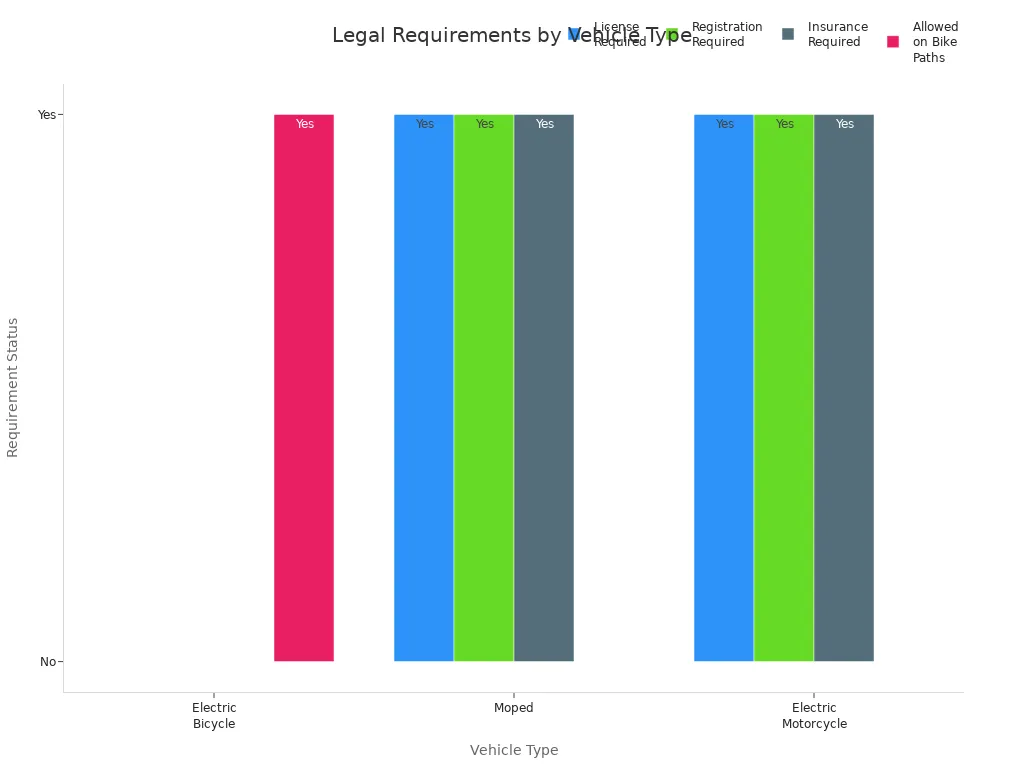
If you choose an s-pedelec, check your state’s laws. Some states treat s-pedelec bikes like mopeds, so you may need a license and registration. Always make sure you know the rules before you ride any electric vehicle.
Choosing the Right Ebike

Assessing Needs
You should start by thinking about how you plan to use your ebike. Do you want to ride for fun, commute to work, or explore trails? Each e-bike class fits different needs. The table below helps you compare the main features:
|
Factor |
Class 1 E-Bike |
Class 2 E-Bike |
Class 3 E-Bike |
|---|---|---|---|
|
Intended Use |
Recreation, short commutes |
Urban, short commutes, throttle option |
Fast commuting, longer distances |
|
Max Speed |
20 mph |
20 mph |
28 mph |
|
Throttle |
No |
Yes |
No |
|
Legal Access |
Most bike paths/trails |
Most bike paths/trails |
Roads, bike lanes, often restricted |
|
Experience Level |
Beginners, casual riders |
Beginners, intermediate |
Experienced riders |
|
Budget Range |
$600-$3,000 |
$500-$2,500 |
$1,200-$5,000+ |
If you want a relaxed ride on california trails, a Class 1 e-bike works well. For city trips in california, a Class 2 ebike gives you throttle power. If you need speed for long california commutes, choose a Class 3 e-bike.
Matching Local Laws
You must follow california laws and local rules when you pick an ebike. Each city in california may have different rules for where you can ride. To stay legal, follow these steps:
-
Check your e-bike’s class. This affects where you can ride in california.
-
Visit california’s DMV or transportation websites for the latest rules.
-
Review city ordinances in california, since local laws may differ.
-
Make sure your ebike meets california’s helmet and age requirements.
-
Keep your e-bike within california’s speed and power limits.
-
Join california biking groups to learn about updates and safe riding spots.
📝 Tip: Always check for new california regulations before you ride. Laws can change, and staying informed keeps you safe and legal.
Safety Tips
You need to ride safely, especially in busy california cities. Here are some important tips:
-
Learn the rules for your e-bike class in california.
-
Wear a helmet every time you ride, even if california law does not require it.
-
Check your battery and brakes before each ride.
-
Use lights and reflectors, especially at night in california.
-
Ride with traffic and obey all california traffic signals.
-
Watch for car doors and pedestrians on california streets.
-
Practice starting, stopping, and shifting on your ebike before riding in busy california areas.
🚦 Alert: Safe riding in california protects you and others. Good habits help you enjoy your ebike for years.
Understanding e-bike classifications and regulations helps you ride safely and legally in california. Laws change often, especially in california, so always check local rules before you buy or ride. You can find updates from california advocacy groups, official websites, and cycling organizations.
-
E-bikes fall into three classes, each with different speed limits and access in california.
-
State and local laws in california may set age, helmet, or trail rules.
-
Regular maintenance and safety gear keep you protected on california roads.
|
E-Bike Class |
Best For Riders Who Want |
Legal Access in california |
|---|---|---|
|
Exercise, most trails |
Fewest restrictions in california |
|
|
Class 2 |
Throttle, easy riding |
Some trail limits in california |
|
Class 3 |
Speed, fast commutes |
Most restrictions in california |
Choose the e-bike class that matches your needs and legal access in california. Stay informed to enjoy safe, fun rides.
FAQ
What is the difference between pedal-assist and throttle on an e-bike?
Pedal-assist helps you when you pedal. Throttle lets you move the bike without pedaling. Class 1 and 3 e-bikes use pedal-assist. Class 2 e-bikes have both pedal-assist and throttle.
Do I need a license or insurance to ride an e-bike?
You do not need a license or insurance for most Class 1 and Class 2 e-bikes. Some states require registration or insurance for Class 3 e-bikes or faster electric vehicles. Always check your local rules.
Can I ride my e-bike on sidewalks or trails?
You can ride Class 1 e-bikes on most bike paths and trails. Class 2 e-bikes face more limits, especially with throttles. Class 3 e-bikes usually stay on roads and bike lanes. Always look for signs and follow local rules.
How do I know which e-bike class is right for me?
Think about where you want to ride and how fast you want to go. Use this list to help:
-
Class 1: Most trails and paths
-
Class 2: Throttle option, city rides
-
Class 3: Fast commutes, road use
📝 Tip: Always match your choice to local laws and your riding needs.






 S2
S2
 KS4 Pro
KS4 Pro
 MAX Pro
MAX Pro



 Light-Weight & Portable
Light-Weight & Portable
 Long Range
Long Range
 For Heavy Riders
For Heavy Riders
 Big Wheel
Big Wheel
 With Seat
With Seat
 Fast
Fast

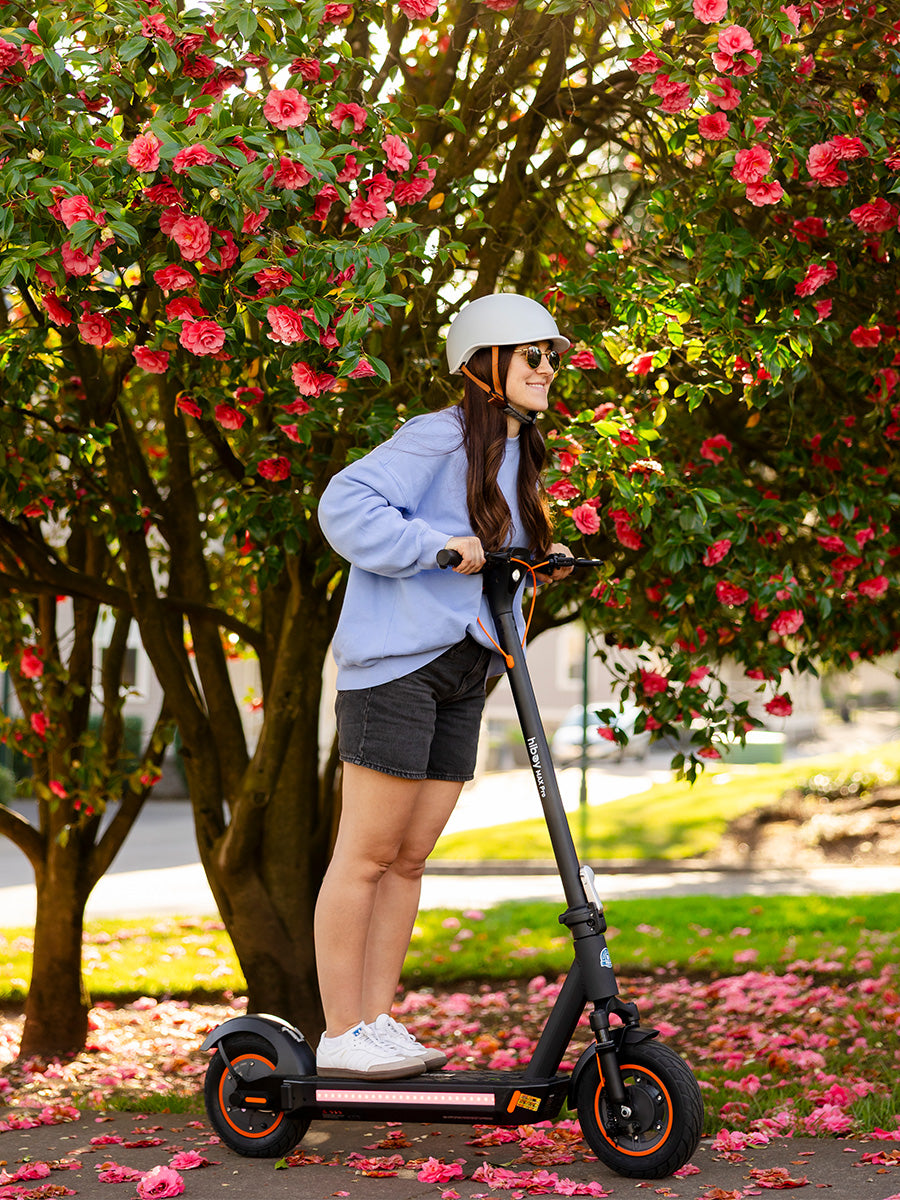

 EX6
EX6
 P6
P6
 C1
C1

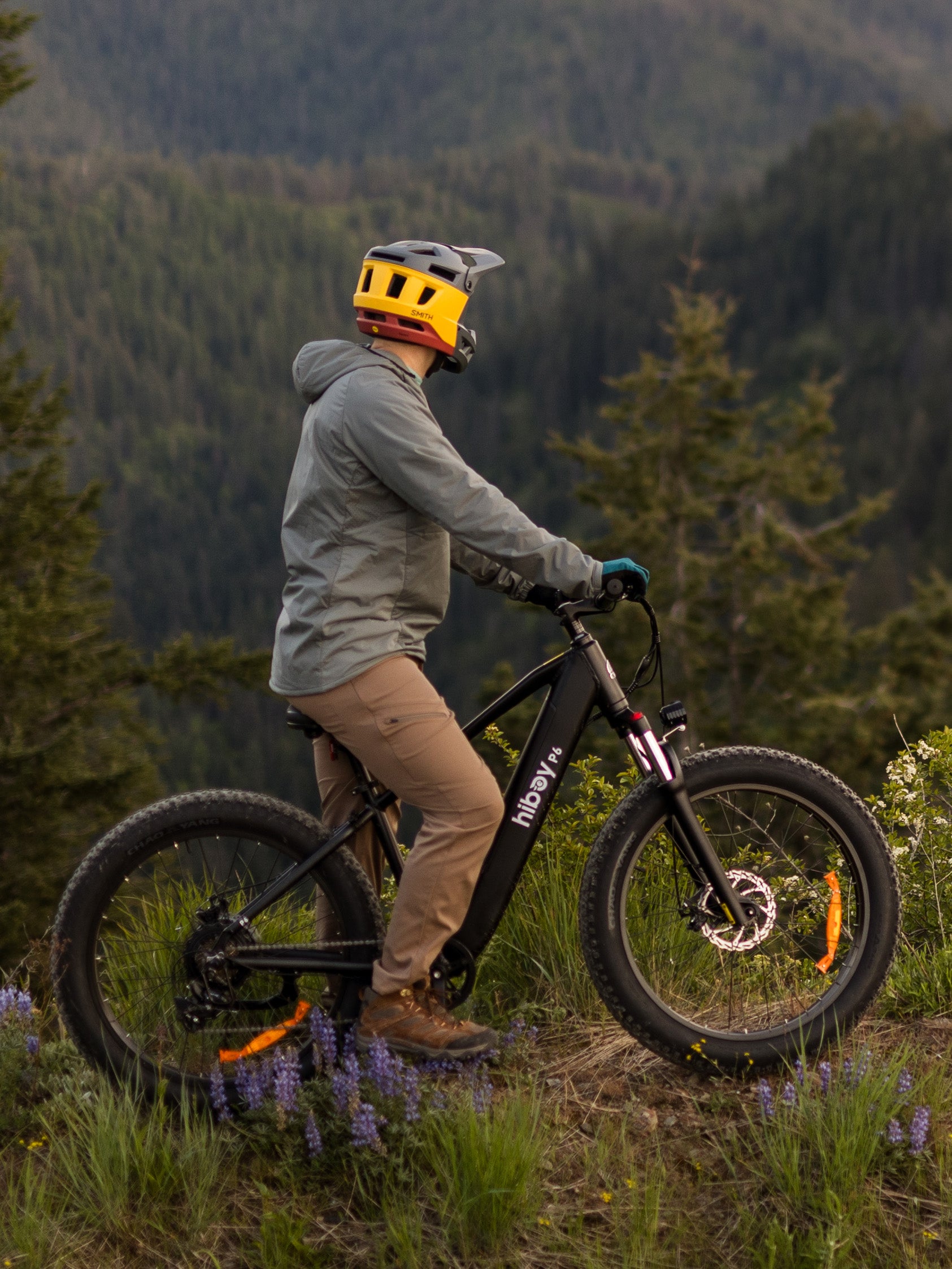
 S2 Lite
S2 Lite
 Q2 Lite-A
Q2 Lite-A
 ES-1
ES-1
 KS1
KS1
 Q2 Lite-A
Q2 Lite-A
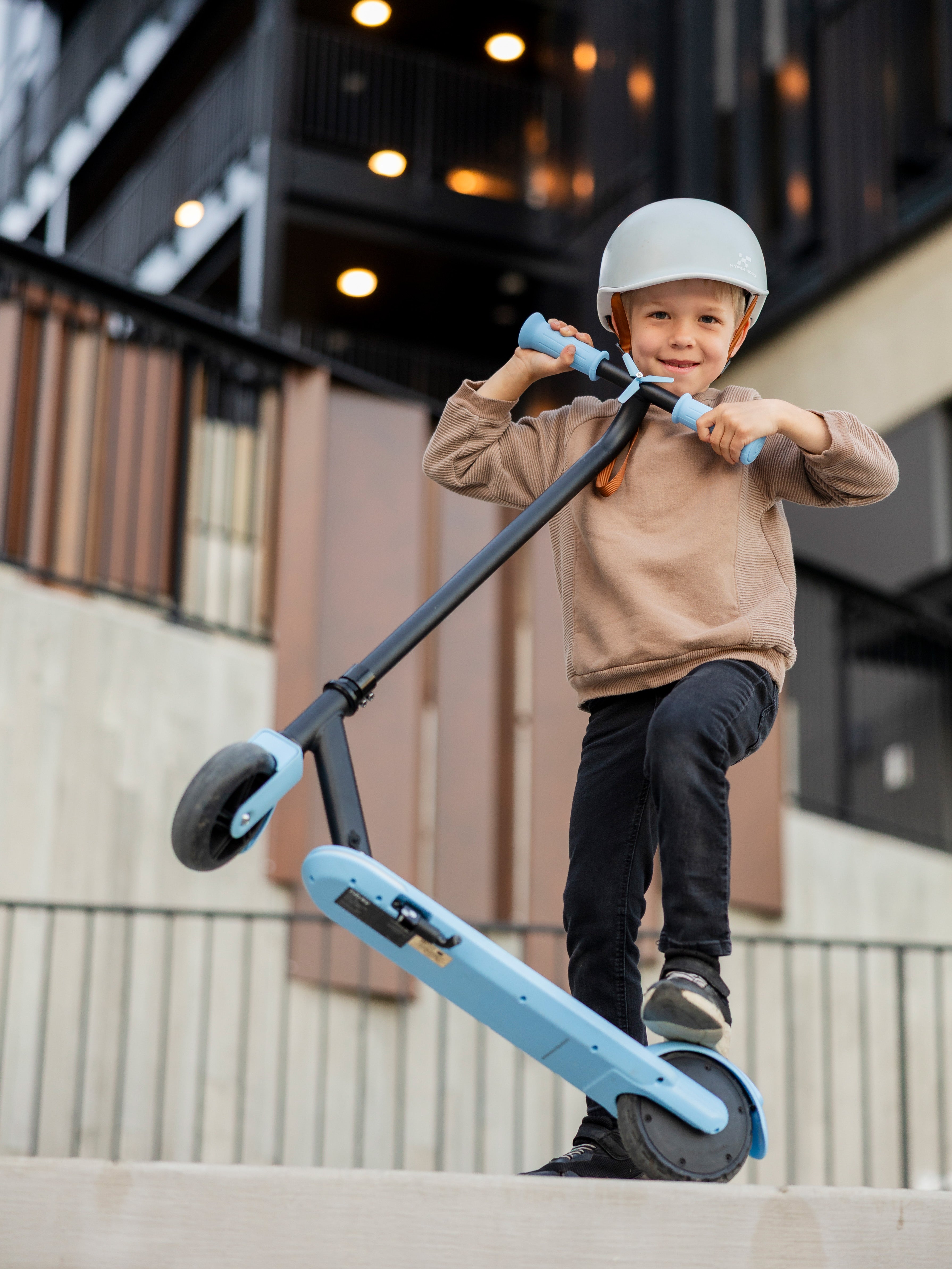
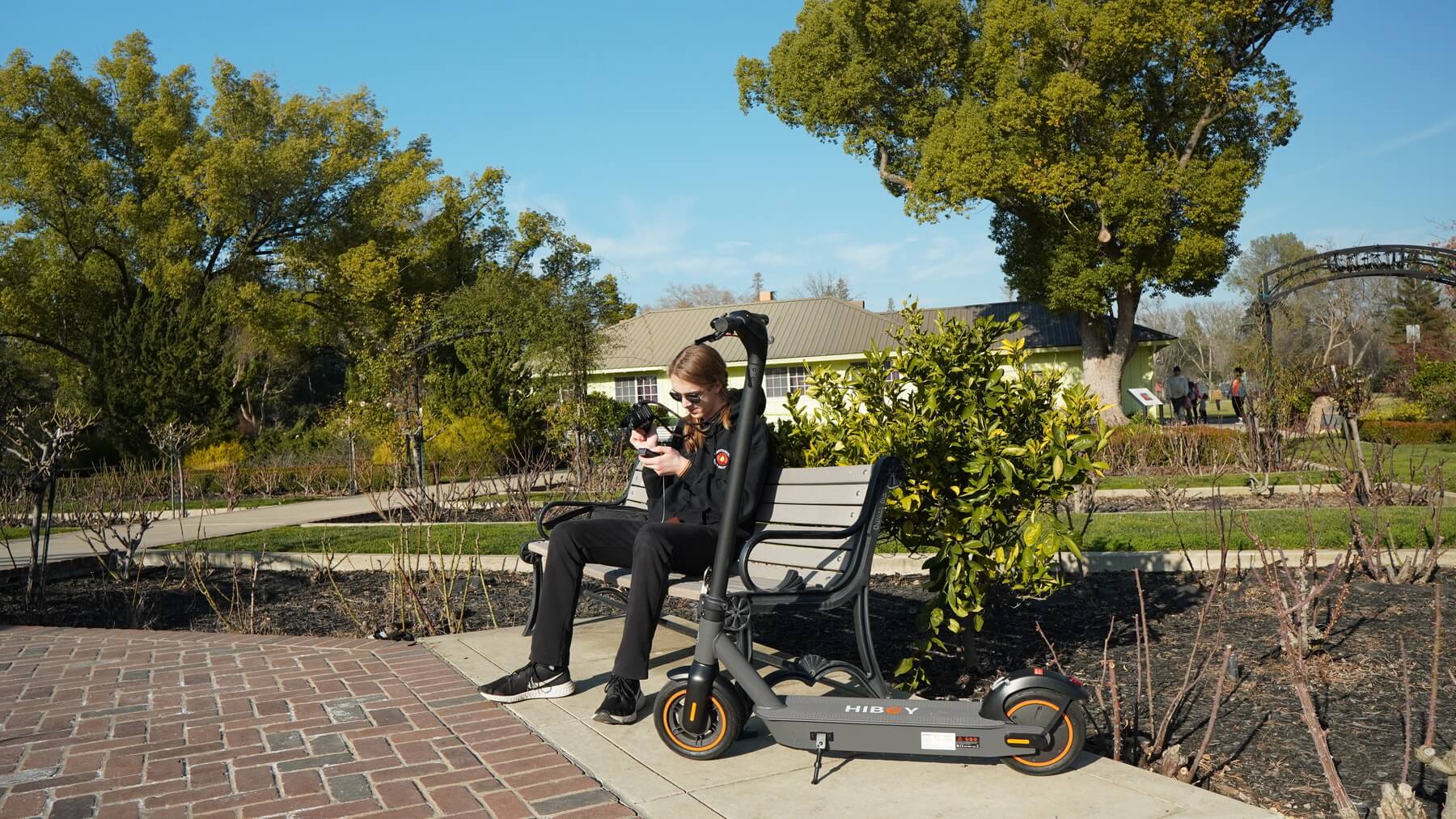

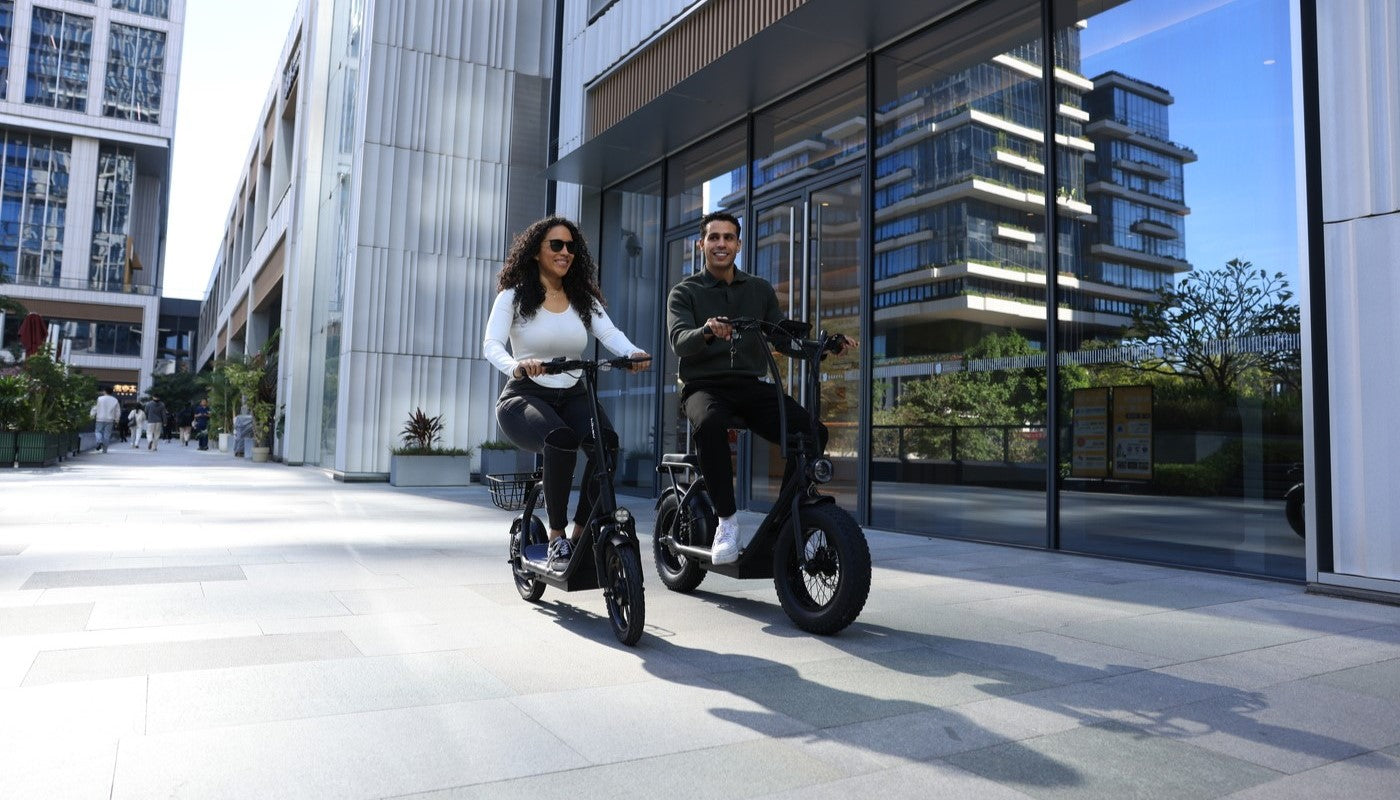






Leave a comment
All comments are moderated before being published.
This site is protected by hCaptcha and the hCaptcha Privacy Policy and Terms of Service apply.